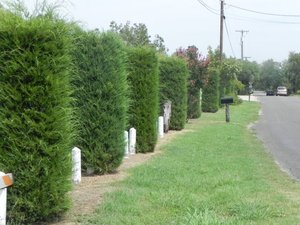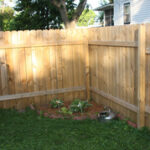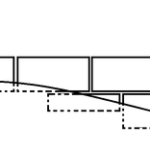Most people think of hedges as rows of bushes or shrubs forming a fence or boundary. Add low-growing trees to this sentence and you have a dictionary definition. Most hedges are trimmed and sculpted for uniformity and beauty. Hedges can be near the home or arranged to direct foot traffic. Practical reasons for hedges are privacy and sound control. This is how you can do it.
My Uncle bought farmland in 1927. He had no reason for privacy or sound control. The roads were dirt and the nearest neighbor was more than a mile away. There were no trees and shifting sand piled high in dunes. He planted an acre of close-packed trees for firewood and a row completely around the farmhouse for a windbreak on three sides. The back side was lined with low plum bushes-what we called sandhill plums. Eventually civilization encroached and the original thickets surrounded a private wonderland for family and friends. Years later I bought 20 acres alongside a busy state highway and proceeded to build El Rancho Tranquilo, or Peaceful Ranch. Only it wasn’t. High speed cars going past on highways at all hours of the day sound like rockets, or worse. As I cleared trees and brush hundreds of eyes floated by every day. It’s funny to say but I felt like we lived in a fishbowl next to a super highway. Part of this is probably because I’m a cantankerous old guy but I prefer quiet and privacy. This is when I remembered my Uncle’s old farm and knew I had a solution.
Privacy hedges only need to be thick and high enough to block fleeting eyes. If somebody stops and peers through holes in the hedge you’ve got other problems. Six feet is usually high enough.
Hedges for sound control need to be high and thick enough to to deflect and deaden sound. Eight to ten feet and higher works best for sound control. A thicket of trees along the property line can do wonders with sound. A windbreak is an added benefit.
Pruning is necessary to provide the anticipated control. Trees and brush left to grow uncontrolled become unkempt, ugly and prone to disease.
Hedge plants and trees–there are hundreds of trees and shrubs available. Do a search for those that do best in your area. Here are a few for central Texas. There are multiple varieties. Choose one that meets your requirements or can be pruned to fit. Be original, try something different.
Boxwood
Crepe Myrtle
Juniper
Holly
Dwarf Hawthorne
Wax Myrtle
Sumac
Cactus
Yucca
Texas Palmetto
How I created my privacy and sound control hedges.
Across the front I planted a variety of juniper, red bud and figs. Honeysuckle and maypops line the winding drive.
On the sides of the property I encourage and cultivate a swathe of mesquite, honey locust and osage orange, which I harvest for special projects.
And across the back-yes, sand hill plums-to complete the journey back to that wonderful place deep in memory.
More from Gerald:
How I Installed a New Metal Roof
Five Reasons for Remodeling or Adding on to Your Home
Add Insulation to Your Attic or Floor





